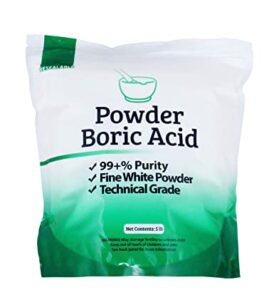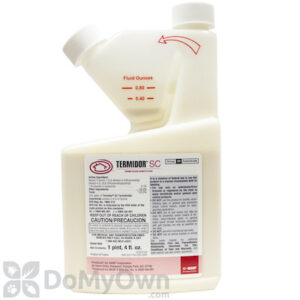5 Ways to Get Rid of Termites In Your Kitchen
Termites may be as tiny as a grain of rice, but the damage they cause is often severe. Since they work like stealthy beasts, the threat they pose to your home cannot be identified until they have wreaked significant havoc on your property.
Aside from being invasive and pesky, termites leave expensive damages in their wake. Nationwide, their troubles cost an average total of a whopping 5 billion dollars in damages each year, a figure that should leave you worried.
Termites, as you know, are lovers of wood. And your kitchen is one of those places that contain lots of woods, hence, the likelihood of a termite infestation. If you are dealing with a severe or mild termite infestation problem in your kitchen and you have run out of ideas, here are some effective methods to try out. But, before we jump into that, let’s first consider how to identify the presence of this pest.
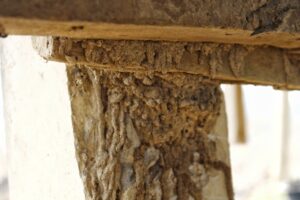
How To Identify and Control Termites in Your Kitchen Cabinets and Floors
If you hear several buzzing noises when you sleep, or you notice you are getting bit by a blood-sucking insect, the chances are that you have mosquitoes in your house and need to act fast. Of course, that is for a mosquito. But what about termites?
Termites wouldn’t blow a trumpet to announce their presence to you, nor will they send a mail to you announcing their impending arrival. So if you want to expunge these wood-hungry monsters from your kitchen, you’ll need to identify them first.
Lucky for you, we have highlighted some helpful signs that indicate the presence of termites.
1. Blisters In Wood Flooring
Do you notice weird blisters in your wood flooring but overlook it as a minor wood default? If yes, then the next time you note such a sign, you need to act as if you may be dealing with a severe termite infestation.
2. Hollowed or Damaged Wood
Hollow or damaged wood is a telltale sign of termite infestation. These damages can be found below and behind surfaces like the walls in your kitchen, its floors, cabinets, etc.
Such a wood defect can result from termites chewing through the wood in search of cellulose, leaving behind long grooves, and reducing the integrity of your property in the process. In addition, hollowed wood has a honeycomb interior and, when tapped, produces an empty sound, similar to that of an empty drum.
3. Evidence of Swarms
Like a few other insects, Termites move in a group, thus making it easy to detect their presence. Once you spot discarded termite wings around your kitchen, be it near your windows, doors, or other access points in your home, the sad truth is, you may have termites in your home.
When termites move out of their nest en masse, it’s either they are searching for a mate or an ideal place to begin a new colony. When they land, they internationally shed off their winds, as they will never need them again.
After this process, the search for a mate of the best place to build a new colony begins. If you are unlucky, this place might just end up being somewhere in your kitchen. Your awareness of their presence is key to saving your kitchen furniture and your home in general.
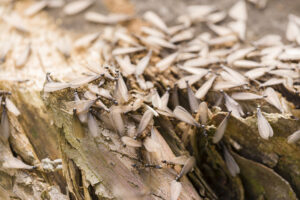
4. Dry wood Termite Droppings
Drywood termites find haven inside of wood. While digging and eating through the wood they are infesting, they create passages they often like to keep clean. To do this, they form kick-out holes where they discard their droppings. And since these insects consume wood, their excrement is wood, which creates mounds of pellets. Seeing these mounds of pellets in your home may signify that you have an unwanted guest.
Now that you know the termite signs, how do you handle them when found in your kitchen?
-
Spray Boric Acid on the Affected Kitchen Cabinets
-
Leverage the Sunlight
-
Make a Simple Cardboard Trap
-
Orange Oil
- Eliminate them like a Pro using Termidor SC
1. Spray Boric Acid on the Affected Kitchen Cabinets
If you discover signs of termite infestation on your kitchen furniture, don’t panic. Instead, prepare a solution of borax powder and water and apply it to the affected areas. The application of borax powder to discard termites is a common and non-toxic method that guarantees maximum results.
Ensure you figure out the affected areas and apply the solution before it is too late. If termites eat through your cabinet, for instance, reducing its integrity, spraying it may be ineffective. Instead, it makes sense to consider RTA cabinets wholesale to replace the damaged cabinets. However, ensure you treat the area properly before installing the new furniture to prevent a repeat.
2. Leverage the Sunlight
Termites enjoy thriving in moist, dark conditions. If you observe the presence of these insects on a piece of kitchen cabinets, removing them and exposing them to sunlight for 2-3 days continuously can help deter termites.
Termites can’t stand the intense heat and die off easily. Aside from killing off the pesky termites, exposing your furniture to constant heat also helps discard the moisture in it, thereby preventing extra infestation.
3. Make a Simple Cardboard Trap.
When troubled by a mouse, how do you get rid of it? By getting a mousetrap, right? Apply the same idea to the termites in your kitchen by making a cardboard trap.
Cardboard consists of cellulose, and it gives off a woody fragrance that termites will kill for. To make this trap more effective, ensure you moisten it with water to give it an attractive smell. Afterward, place it near the affected area and watch termites swarm to the cardboard. You can either discard or burn the cardboard to kill the termites.
4. Orange Oil
Orange oil to termites is like salt to earthworms. This oil which is made of d-limonene is toxic to termites. Orange oil causes the exoskeleton of termites to melt, which results in them losing their moisture and proteins. The end result? Excruciating death!
Spray the orange oil directly onto termites or in places where you suspect their presence. If you want to ward off these insects, you can spray the oil on the area of interest.
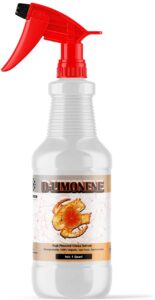
Alliance Chemical 100% D-Limonene – One Quart Spray Bottle – All Natural – Made From Extract Of Orange Peels
5. Eliminate them from exterior walls using Termidor SC
Termidor SC is a great termite control product for professionals and homeowners alike. It can only be used outside as an exterior treatment but it can protect and eliminate the termite colony if they are on an exterior wall. It’s not just effective against pesky insects, but it also protects your home from future infestations by safeguarding all of its parts including foundations. Termidor can protect your home and eliminate almost any termite problem in less than 90 days. It also can be used as an in-ground barrier treatment. If the termites are trying to enter your home from an exterior wall it will keep them at bay.
How to Use Termidor SC
Conclusion
The key to getting rid of termites in you kitchen is noting their presence in time. Don your detective goggles and scrutinize likely areas that may be harboring these insects. Once located, implement any of the methods above. But if the termite infestation is more than you can handle, ensure you contact the necessary experts such as your local termite control.

